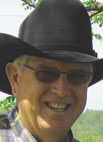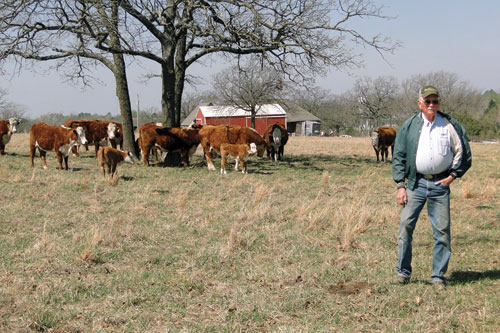Sara and Jim Shelton market their farm-born and raised, grass-fed beef across Oklahoma
VINITA, OKLA. – Sara and Jim Shelton’s cattle are fattened naturally on Oklahoma’s finest grasses.
Shelton Family Farm and Sara’s Grassfed Beef is in Craig County, near Vinita.
The cattle receive no hormones and lead very low-stress lives, said Sara.
When processed, the beef is dry-aged, offering a rich beefy flavor. High in omega-3 fatty acids and conjugated linoleic acids, the cattle are delivered to a USDA-inspected facility in Big Cabin.
For more than three decades, Jim was an ag lender at a locally-owned bank while Sara was busy raising the couple’s four children and helping with the cattle.
That all changed in 2010, when Sara’s father retired, and Jim decided to leave the bank.
“We began leasing some pastures from him and increased the number of stocker steers that we buy,” Sara said.
Sara grew up on a cattle ranch northwest of Vinita, a cow/calf operation using commercial Hereford cows and registered bulls.
“In the late 1970s and early 1980s, my dad switched to a stocker steer operation,” Sara said.
Jim grew up 6 miles east of Vinita on a cattle ranch and began buying land and his own cattle while in high school.
“We got married in 1975 and have had cattle ever since,” Sara said.
The ranch, which is about 3,500 acres in total, runs about 150 cows and replacement heifers and graze enough stocker cattle to utilize the remaining grass on the couple’s pastures.
The Sheltons have considered multi-species grazing but have not had the time to add the infrastructure needed to incorporate sheep or goats.
“We used small-medium frame registered Red Angus bulls from Ozark Hills Genetics and Pharo Cattle Company for the past 15 years in an attempt to get our herd to a 1,000-to-1,100-pound weight for our mature cows,” Sara said.
The cattle do very well in a grass-based program, she said.
“We buy stocker steers in September and October,” Sara said.
“They are backgrounded in Texas, arriving in Oklahoma in late October through December and pasture on native prairie until sold and shipped out late July.”
Shelton Family Farm and Sara’s Grassfed Beef uses natural cover breeding program.
“We aim for a 60-to-75-day calving season,” Sara said. “We calve in late August through early October in order to match the nutritional needs of our pregnant cows to the availability of forage for them.”
This gives the pregnant cows time to get in great shape on summer grasses before they calve and the grass is still good as they go into early lactation, she said.
The goal is 60-to-75-day calving season followed with a fence line wean in early June, she said.
“We have fescue that will help us out in the fall until it starts to frost,” Sara said. “We stockpile grass for winter feeding.”
The Shelton’s like the fall because with adequate stockpiling of grass in late summer helps mitigate the need to feed hay and they can avoid the hassle of calving in January and February because of the harsh weather.
“About 20 years ago I attended a Stockman-Grassfarmer seminar on grass fed beef and started direct marketing grass-fed beef,” Sara said.
“For the grass-fed beef program, we use our replacement heifers that did not breed or lost a calf,” Sara said.
Shelton Family Farm and Sara’s Grassfed Beef is listed on eatwild.com and have been picked up by a couple of other similar lists.
“I market both individual cuts of meat as well as selling whole and half beefs,” Sara said. “We sell from our home, and I have participated in an informal Saturday farmers market at Langley for several years.”
Shelton Family Farm and Sara’s Grassfed Beef has customers in Northeast Oklahoma, as well as the Oklahoma City area.
“We are currently selling around 12 to 15 head a year,” Sara said. “I only sell beef that has been bred, born and finished on our property.”
“We like to have as many different forages — grasses — as we can so our cattle have a good selection for grazing,” Sara said. “We do supplement the cows and stockers with a high-protein feed through the winter as well as stockpiled grass so they do the work to graze rather than us feeding hay.”
Shelton Family Farm and Sara’s Grassfed Beef has some baled hay on hand in the event of extreme weather events, she said.
Other cattle are supplemented with alfalfa pellets.
The cattle are wormed, vaccinated and any other preventive measures, Sara said.
“We deworm with Safeguard as needed and a pour on for ticks in the spring,” Sara said. “Heifers are calfhood vaccinated for brucellosis and all calves are vaccinated for blackleg, lepto and IBR/BVD.”






